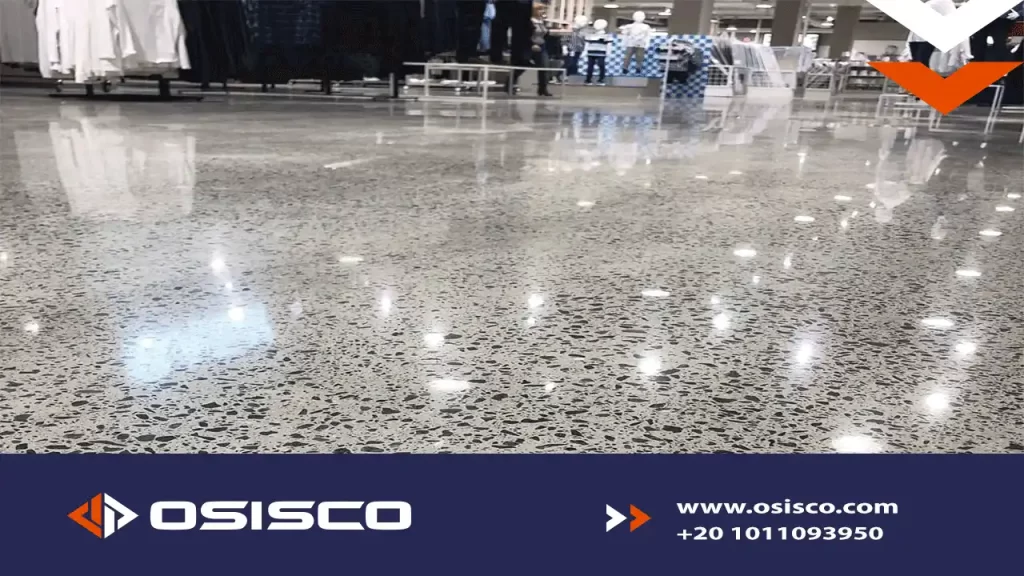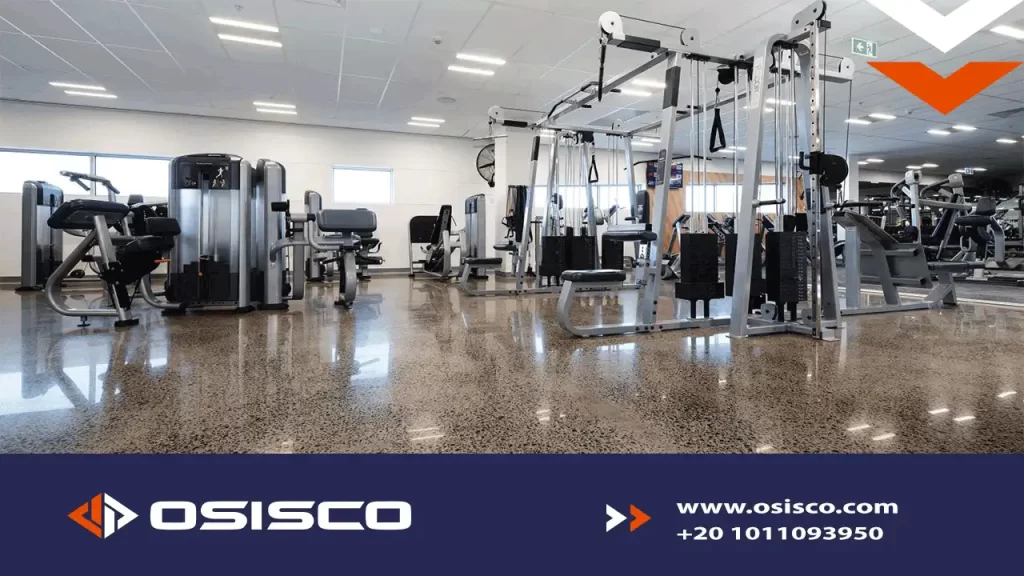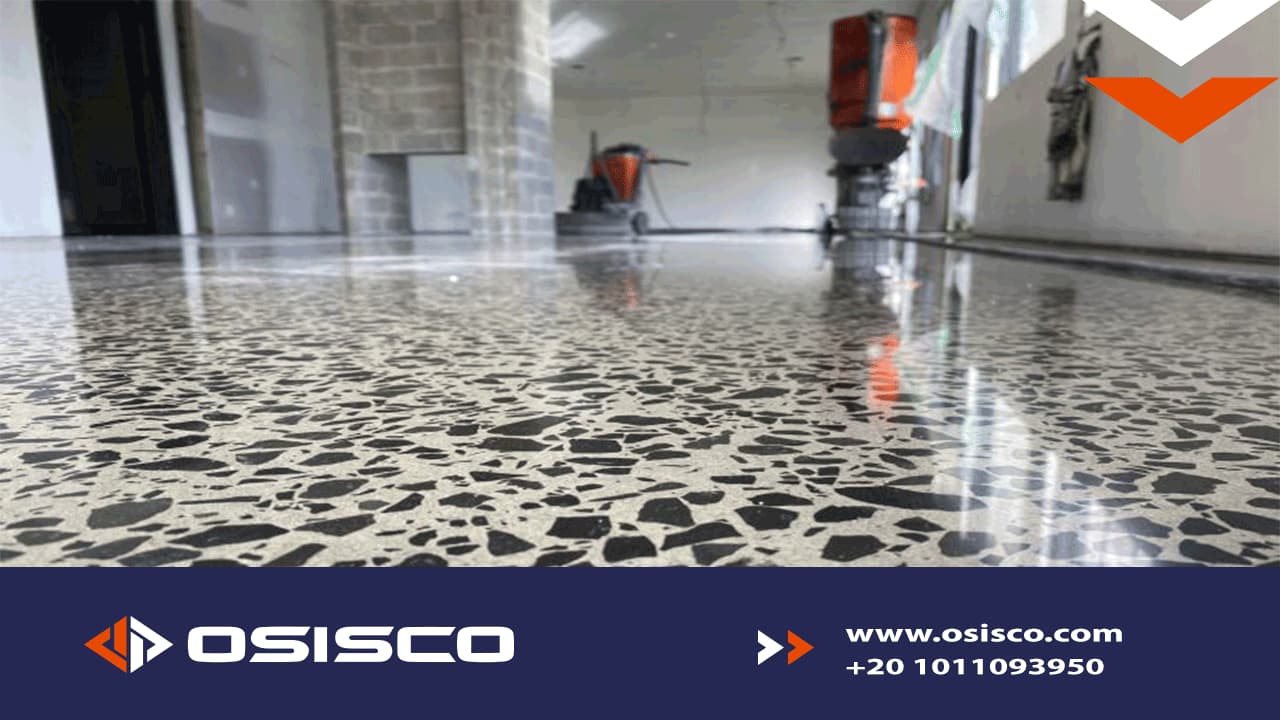Polished concrete floors radiate a refined and luxurious atmosphere and have become popular in residential and commercial architecture.
An important factor in this popularity is its versatility and aesthetic appeal. From bright color palettes to muted hues, polished concrete can be shaped into various shapes, and you can experiment with diverse and distinctive design styles, next we will know more about it with OSISCO.
A remarkable variety of possibilities are available for coloring, grading, and designing radial lines, grids, bands, borders, and other patterns on polished concrete’s smooth, reflective surface.
The possibilities are limitless, but before you explore the scope of customization, you should know the different types of polished concrete floors. We will provide you with all the information about polished concrete in this guide.
What is polished concrete?
Before delving into the different types of polished concrete floors, it is necessary to get a brief idea of what polishing concrete entails. It is a multi-step mechanical process in which concrete is ground and honed before being polished with the help of bonded abrasives.
Powerful grinding tools are used to cut the surface of the floor and remove any imperfections. This step focuses on smoothing the surface and is widely known as “cutting”.
Next, the floor surface is further cut with less aggressive grinding tools to achieve the desired level of smoothness or reflectivity. This process is known as “polishing”.
Next, a penetrating chemical compound known as a hardener is applied to the surface to harden it and make it dustproof.
read more about 2023 Marvelous Guide for Floor Epoxy Resin Egypt

Polished concrete floors are very durable, and you can choose the level of gloss according to your requirements. Once polished, the concrete surface can be stained or stained, and you can experiment with different design options.
Apart from residential areas, polished concrete floors are commonly used in:
- Warehouses
- Restaurants and hotels
- Retail showrooms
- Medical and educational facilities
- office buildings
Types of polished concrete floors
Polished concrete floors are of several types, depending on the finish and quality of the concrete. In this section, we’ll look at the three most common types.
- Cream-polished concrete polished concrete
Also known as a “bronze” finish, it is one of the simplest forms of concrete flooring. Here, the surface of the concrete is not ground or honed but is simply polished with diamond pads to enhance the natural color of the floor.
Since there is no removal of concrete from the surface of the earth, the natural coloration and texture of freshly poured concrete will be visible, giving it an aesthetically appealing appearance.
Besides, this type of polished concrete floor has a very organic look and is very common in residential areas, especially new buildings. Moreover, if you want to improve the appearance of your floor even further, simply stain the concrete.
However, a creamy finish can only be achieved if the concrete floor is smooth and undamaged. If the surface is uneven, grinding becomes necessary to reach a flat area.
Therefore, cream concrete floors only work on freshly poured concrete surfaces that do not have any stains or scratches. As such, the final appearance depends greatly on the quality of the concrete mix and the casting technique used.
- Exposed Aggregate Finish polished concrete
For those who may not know, aggregates are coarse or fine-grained particles such as crushed stone and sand used in the construction process. In an exposed aggregate finish, the surface of the concrete is heavily ground to expose the aggregate in the concrete mix.
In this process, the cement paste is ground to remove its outer shell and to expose the larger, uneven aggregates in the concrete slab. The surface of the exposed aggregate is much like a granite block and is slip resistant. Moreover, it can withstand extreme weather conditions and heavy foot traffic.
read more about Self-leveling epoxy what are its best benefits?

The color of the rubble depends on its geological origin and can vary from earthy brown tones to pink quartz and red granite.
Besides, you can opt for decorative aggregates to give your concrete floors a unique look. Usually, people prefer natural stones such as granite, quartz, limestone, or basalt, but some also choose recycled colored glass or mother of pearl.
The most important feature of the full aggregate finish is that it is very durable and can achieve different texture variations. Often, the aggregate is mixed with the concrete, but in some cases, the aggregate is sprinkled onto freshly poured concrete and spread using a bull float. Therefore, it is the perfect combination of durability and versatility.
- Salt and Pepper Finish polished concrete
Also known as “golden” concrete, the concrete surface is gently milled into this type of finish to reveal small aggregates beneath the surface paste. As the name suggests, exposing the refined grains of the aggregate gives the surface a mottled or salt-and-pepper appearance.
In this type of concrete, the floor is polished to provide a high-gloss finish, which makes it different from exposed aggregate finishes, in which the surface is given a matte appearance. Besides, you can customize the look as per your preferred color and sheen level.
An important advantage of the salt and pepper set for polished concrete is that it can blend with any structure, be it residential or commercial. It is very durable, reflects light, and gives a unique look to your floors, which is why it is the best choice for restaurants and shopping malls.
Usually, this type of concrete flooring is very popular in residential renovation projects where a creamy concrete finish cannot be used. But it is more expensive than cream-polished concrete, and installation takes longer. In addition, the detection of micro aggregates is a complex process that can only be done by experts.
read more about Epoxy flooring | What are the best advantages of it?
Advantages of polished concrete floors

Now that we’ve looked at the different types of polished concrete floors, let’s take a look at some of the reasons why they are among the most attractive flooring solutions:
- Longevity
Polished concrete surfaces are very durable and less prone to staining. As such, it lasts longer than vinyl, carpet, wood, and other types of flooring. Besides, polished concrete is usually hardened, which means it’s durable and less likely to chip or crack.
- Easy maintenance
Polished concrete surfaces are not prone to stains and do not accumulate dust particles or allergens. Although it does require regular maintenance, the requirements are manageable. All you have to do is clean the floor with a damp cloth and chemical cleaner regularly.
Keep in mind that if polished concrete is not routinely cleaned, it may lose its luster over time. Spot cleaning should be done with extra care, and weekly cleaning should be done with detergent and water. Don’t make the mistake of applying a waxy coating to polished concrete, as it dulls the surface.
- The sustainable solution
Polished concrete floors are a very sustainable flooring option for several reasons. First, it is naturally reflective and reduces the need for artificial lighting. This makes it an excellent choice for businesses, schools, and other high-traffic areas that need a clean, bright appearance.
Plus, polished concrete floors don’t need harmful coatings, chemical cleaners, or adhesives. Also, since it uses an existing concrete slab, it requires no additional materials. So, all these factors make it a greener choice for flooring.
- Allergen-free
Polished concrete is a hypoallergenic flooring option. Besides, it is non-porous and does not allow moisture or dust particles to pass through. Thus, the chances of mold formation are reduced, and since contaminants cannot enter the surface of the concrete, it remains clean and allergy-free.
Therefore, it is a great flooring option for people who are allergic to dust, pet dander, and other pollutants.
read more about Metallic Epoxy What are its top benefits?
- Skid resistance
Polished concrete floors are slip resistant if kept clean and dry. Additionally, it is much less slippery than other flooring systems like polished marble and waxed linoleum. So, don’t be fooled by the smooth appearance of the surface.
Summarize polished concrete floors
We hope our guide has given you a comprehensive overview of the different polished concrete floors and their associated benefits. Besides, you can enhance the overall look of your flooring by adding elegant pieces and area rugs to your space. With the right preparation, nearly any concrete floor that is fundamentally solid, whether it is new or old, may be polished.
In short, polished concrete is a versatile and cost-effective flooring solution, but keep in mind that it’s essential to hire a professional to polish the surface. This is because the polishing concrete process is complex and requires expertise and heavy-duty polishers.
